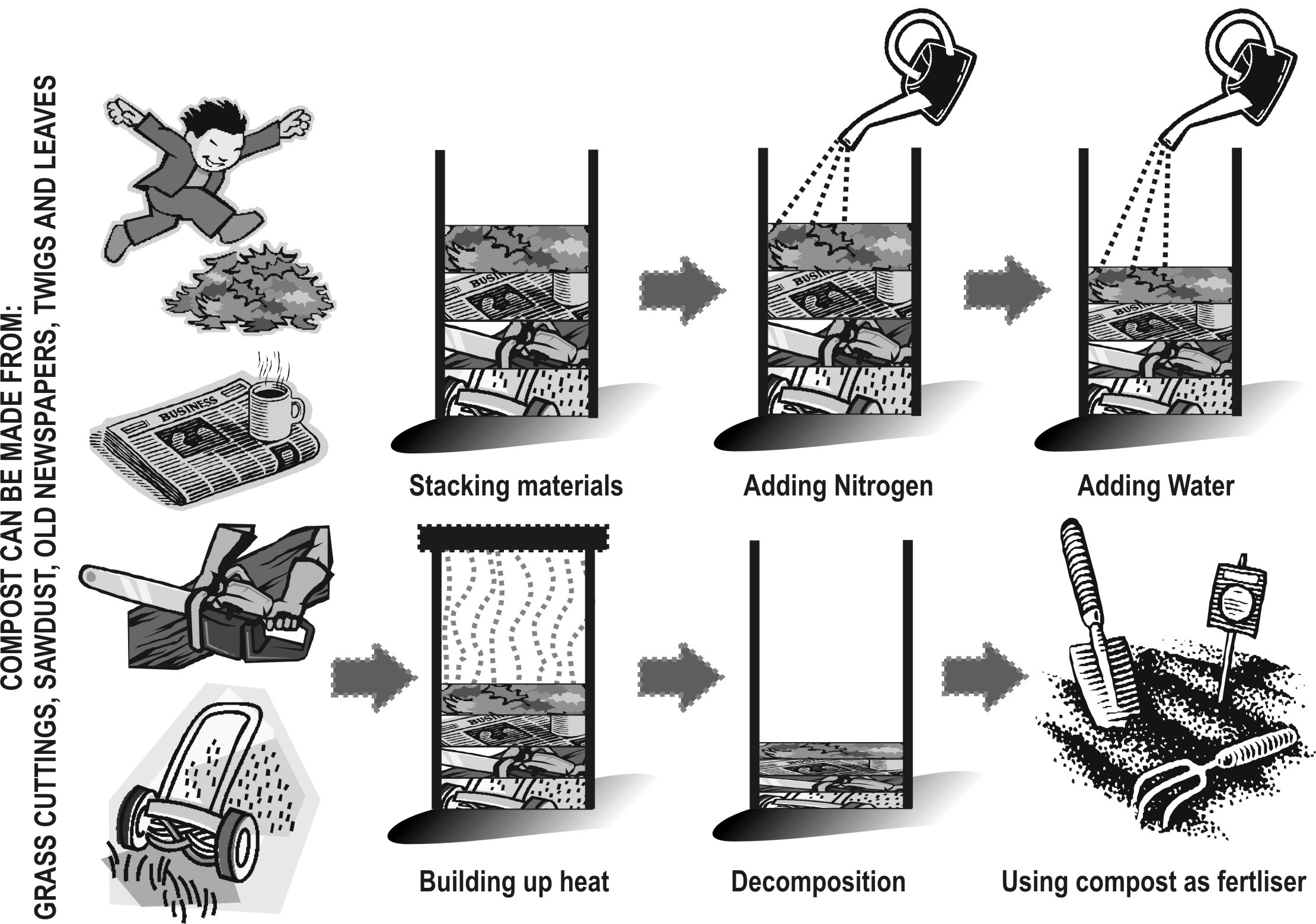Natural fertilisers: in a natural environment the only soil enrichment that occurs is through the decomposition of organic material. The nutrients derived from this process are slowly released back into the soil system. Limited nutrient loss occurs as the system is constantly cycling the nutrients.
If this area were to be farmed, a significant loss would occur because the crop is harvested and removed. Sustainable farming requires the farmer to replace the nutrients that are lost by crop production.
There are two key components in the making and use of natural fertilizers; manure and decomposing plants. Manure is available from domestic livestock and poultry. Decomposing plants are available from plant off-cuts and the discarded parts of plants.
The section below is an illustration of the process of compost and other natural fertilisers that can be produced from constituents that would normally be treated as waste.
It is important to use these materials properly so as to avoid the transfer of diseases and to ensure that the strength of the materials produced does not harm plants during application.
How to make compost from your organic waste material:

Waste from the garden and table does not have to be disposed of. This can be condensed and reused as fertiliser through a process called composting. To make a good compost heap you will need about five wheelbarrow loads of ‘wet’ materials and ‘dry’ materials, as well as about two wheelbarrow loads of either compost or well-rotted manure. You will also need access to water.
Instructions for Composing
Step 1: If there is a species of grass that sends out runners, cover the compost heap area with a thick layer of cardboard to prevent the grass from growing into the heap. Otherwise, the heap can be made in any sheltered position.
Step 2: Cover the area with a 20 – 30cm layer of branches and coarse materials to allow for aeration and drainage. It should be like a thick mattress. Ask someone to hold a long straight pole upright in the middle of the heap so that the rest of the heap can be built around this; the pole will be removed later to allow for air circulation.
Step 3: Put a 30 cm layer of wet organic (green leafy) composting material on top of the coarse materials. Green leafy materials such as comfrey, tansy, clover are good compost activators. This layer can include weeds, vegetable and kitchen scraps. Exclude diseased plants, weeds with seeds and grass such as Kikuyu that grows with runners. Keep the sides as straight as possible, as if it was a bed.
Step 4: Next, add another 30cm layer of dry material on top. This layer can include leaves, mulch, maize stalks and dry grass.
Step 5: Put a 5 cm layer of activating material, e.g. old compost or manure, on top of this.
Step 6: Water the two layers that have been placed so far so that it is as wet as a squeezed sponge.
Step 7: Repeat the process from Step 3 to Step 5 until the heap is about 1.5 m high. It is important that the heap should be high enough to place enough pressure on the rest of the heap because this helps the heap to heat up, which in turn helps the activation process.
Step 8: Cover the top of the heap with some material that will keep out rain and retain heat. Black plastic sheeting, soil or dry grass all work, remembering to remove the chimney pole first and to keep the chimney open to allow air to circulate.
The heap should heat up within about two days. Hold your hand over the ventilation hole and feel whether or not it is hot. If it not heating up, remake the heap, adding more activating materials.
When the compost heap has cooled down – six to ten weeks later – the compost heap can either be turned inside out so that the materials that were in the middle are now on the outside and top, or a spade full of compost earthworms (the red ones) can be added to the heap. The earthworms will take about six to eight weeks to turn the heap into good compost. If the heap is turned, it should heat up again, and once it has cooled down it is ready to use. When the composting process is complete the heap should be dark brown in colour and the organic materials that were used to make the compost no longer recognisable.
Click here to view a video that explains compost vs manure.